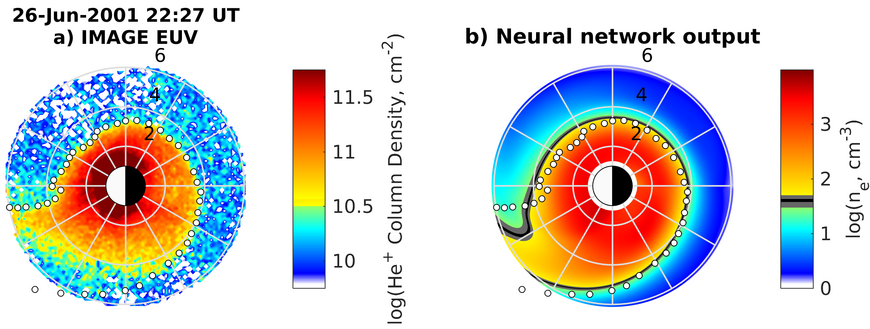Irina Zhelavskaya: Invited talk
September 2017
Invited talk "Empirical modeling of the plasmasphere dynamics using neural networks", Space Weather: A Multi-Disciplinary Approach Workshop at the Lorentz Center, September 25-29, 2017, Leiden, the Netherlands.
Irina Zhelavskaya: Invited talk
August 2017
Invited talk "Deriving electron density from electric field measurements on the Van Allen Probes spacecraft and building a global dynamic model of plasma density using neural networks", IAPSO-IAMAS-IAGA 2017, August 27 - September 1, 2017, Cape Town, South Africa.
Machine Learning
Machine learning (ML) is a rapidly evolving field of research that has advanced various areas of modern research. For example, it is used in fraud detection, search engines, credit scoring, automation, email spam filtering, and many others. Unlike traditional methods, which are mainly used in linear problems, ML methods have their advantage in nonlinear problems with multiple input variables and are surprisingly effective. An important aspect of this is that ML relies on an abundance of data. In our research, we apply machine learning methods and algorithms to space-related problems to develop new data-driven models of various physical phenomena and to improve existing physics-based models. These problems and processes are typically highly nonlinear and very data-heavy, due to the increasing awareness of space weather and an increasing number of scientific missions investigating its phenomena.
We draw on ML methods to develop predictive models of electron density in the plasmasphere and the Kp index. Feedforward neural networks are used in these two projects. They are a very powerful tool to find nonlinear multivariate mappings from input to output parameters. In the case of electron density, the inputs to the model are the time series of the geomagnetic indices (AE, Kp, Sym-H, and F10.7), and in the case of the Kp index, the inputs are the time series of the solar wind and IMF parameters. The figure shown here is an example of the electron density reconstruction for June 26, 2001 22:27 (UT). On the left is the image of the He+ particle distribution in the plasmasphere taken by the EUV instrument aboard the IMAGE satellite, mapped on the equatorial plane. The white dots indicate the location of the plasma pause, which was manually identified from the image. On the right is the reconstruction of the electron density using a neural network for the same time. The color indicates the decimal logarithm of the electron density, and the black and gray section of the color bar shows the approximate location of the plasma pause. The actual position of the plasma pause, taken from the IMAGE EUV data, is also overplotted with the white dots. As can be seen in the figure, the density reconstruction obtained with the neural network agrees quite well with reality. This period is out of sample (i.e., it was not included in the training).
In this project, we will use the developed plasma density and Kp index models to improve the prediction of the radiation belts. In particular, we will integrate the electron density and Kp prediction models into the Versatile Electron Radiation Belt (VERB) Code we have developed, which will provide more accurate prediction of the radiation belt state.
References
Zhelavskaya, I. S., M. Spasojevic, Y. Y. Shprits, and W. S. Kurth (2016), Automated determination of electron density from electric field measurements on the Van Allen Probes spacecraft, J. Geophys. Res. Space Physics, 121, 4611–4625, doi:10.1002/2015JA022132.
Zhelavskaya I. S., Y. Y. Shprits, and M. Spasojevic (2017), Empirical modeling of the plasmasphere dynamics using neural networks, J. Geophys. Res., 122, doi:10.1002/2017JA024406.



